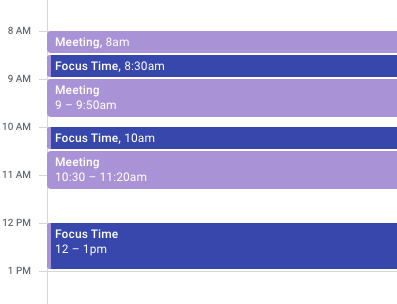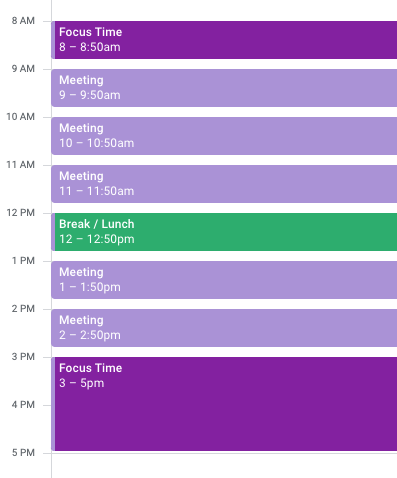
Take back your time: How to unlock the hidden value in your calendar
Main illustration: Sol Cotti
One of the most finite resources we have is time.
And as an Executive Assistant, one of my top priorities is to ensure my leaders not only have enough time in the day, but are able to be effective, efficient, and productive.
Helping them accomplish this isn’t an easy task, but it’s fundamental to their success. Allow too many meetings to pile on to their calendar, and they face some serious hydration and bladder issues. And missing the right meetings on the calendar can overlook important collaborative time.
So how are Executive Assistants able to find time like magicians who pull fuzzy white bunnies from their black hats? While we’re unable to create time, there is a bit of magic to how we manage the time we’re given. I like to think of calendar management in terms of budgeting time – it’s a finite, invaluable resource, after all, so deserves to be carefully accounted for. In this way, calendar management becomes equivalent to allocating value to different priorities, identifying areas that need more investment, and reducing wasteful costs.
Taking insights from my work with product and design leaders at Intercom, I’ll share five tips that will help you renovate your own calendar and rethink how you manage your own time.
1. Not all time is created equal
The value of time varies drastically based on how you split it. We each have 8 hours in a working day, but there are endless meetings and distractions that decide how that time is distributed.
“Two 30-minute time blocks divided by a meeting are usually not as productive as a solid hour of heads-down time”
Two 30-minute time blocks divided by a meeting are usually not as productive as a solid hour of heads-down time. If you consider the amount of time it takes to decompress after a meeting, along with the amount of time it takes to get started on deep focus time, one solid hour will always yield higher levels of productivity.
Returning to the concept of budgeting your time, let’s think about time in terms of money, where hours and minutes are dollars and cents. Your end goal is to make each hour buy as much productivity as possible. If given the choice of 15 minutes or an hour to make progress on a project, the choice is always clear – the hour is equivalent to $100 where the 15 minutes may as well be pennies.
In a traditional structure of 8 am – 5 pm, it’s important to scaffold your calendar in a way that makes it work for you. This is so crucial to protecting your time first, versus leaving it open for others to decide your day for you. When you leave your calendar open to all, you become susceptible to everyone else’s agenda overriding your own and risk ending up with with mere scraps to allocate your time budget.
Here’s an example of a less-than-ideal day that’s been overtaken by meetings scheduled at less-than-ideal times:

This calendar is not so ideal because it breaks apart meetings with focus time versus chunking focus time together.
When building the optimal scaffolding for your calendar, there are two key ingredients to consider. You need to understand and identify the rhythm of both the company and your team, and equally as important, when you’re most productive.

This is an example of what an ideal day could look like. Notice that there’s 10 minutes between meetings for you to grab water or a snack. And, you’ve got focus time at each end of the day to answer emails or dive into deep work on a project.
In the above example, this person is most productive in the afternoons. Therefore, blocking a large chunk of focus time in the later part of the day aligns with their needs. You can begin to build out hour-long (ideally hours-long) chunks of time for yourself where you can really dive into tactical work after meetings.
Once you decide on your rhythm and perfect your calendar scaffolding, leave it in place every week. That repetitive structure is key to managing your calendar – it’ll allow you to anticipate what time you’ll have every day, and allows your team to predict when you’ll be available each week.
“Evaluate where you have gaps of dead space that offer minimal to no value”
Then, evaluate where you have gaps of dead space that offer minimal to no value, what meetings can be shifted around to work best for you, and where in your day you can chunk meetings and focus times into separate clusters.
Think of your one-hour (or more) chunks of time like $100 bills. The more you can collect, the wealthier you’ll be with your focus time. Collecting 15 pennies doesn’t make you wealthy, but collecting 15 $100 bills could certainly take you on a solid shopping spree!
2. Challenge what you agree to
We have all encountered those situations where someone urged us to accomplish something yesterday because they didn’t manage their own time effectively. A priority that is first on their list could be last on ours – our sense of urgency and prioritization shouldn’t be dictated by everyone else.
“No” is one of the most important words to have as part of your calendar vocabulary. When you hear the question “Can I book time during this slot?”, get used to answering “No,” especially if you’re breaking up a valuable $100 chunk of time.
“The biggest question you should answer for yourself is: does this meeting align with the goals and business objectives my team must accomplish this week?”
Booking time on the calendar for my execs is always a negotiation. Even if someone requests 30 minutes during an available time, if there’s a way to optimize that meeting further, I opt to do that instead. When I can say yes right away, I do, because that also saves everyone time. But 80% of the time, I offer alternatives before I freely give away the first option.
Presenting alternatives can seem daunting. However, a big priority for Executive Assistants is to make sure leaders are at the right place at the right time, for the right amount of time, and during the most optimal time. You can use that same thought process when you get meeting invites.
When presenting alternatives, here are some powerful questions:
- By when do you need to have this meeting?
- How much time will you need?
- Is there an agenda planned for our time together?
- Is there pre-work for this meeting?
- Does everyone on the invite list know this meeting is coming?
- Is there any additional context you can share?
As the keeper of your calendar and the protector of your own productivity, the biggest question you should answer for yourself is: does this meeting align with the goals and business objectives my team must accomplish this week? If it doesn’t align, push the meeting to a time that is optimal for you and the requestor, but not a moment sooner.
By saying no to the wrong meetings, you can say yes to the right meetings, yes to more focus time, and yes to creating balance on your calendar.
3. Think about the why
The details matter. The who, what, when, where, how, and most importantly, the why, matter. Who are you meeting with? What will you discuss? When will you need to do it? Where will the meeting happen? Why does this meeting matter? How will we deem this meeting a success? What do you hope to accomplish at this time?
“In order to maximize productivity, every minute of your day should have an agenda – especially your focus time”
Oprah begins all of her meetings by asking everyone in the room what their intentions are. If you don’t have an answer to the majority of those questions, it may make sense to scrap the meeting.
In order to maximize productivity, every minute of your day should have an agenda – especially your focus time. Think about that $100 value chunk of time – if you have an hour to yourself, defining your intention during that hour of personal time is a powerful tool to master your own productivity. Who do you plan to impact? What are you going to work on? When does that task need to be completed? Where will you find maximum productivity? Why this task now? How will you deem it successful?
The time you spend with others is valuable, but the ability to answer those questions for your personal time pays more dividends.
4. The thematic week
We all love a good theme! When applied to the flow of the week, there is immense value to be gained by setting a rhythm and flow to your calendar.
Here are some areas to consider building themes for:
Leadership Meetings: They’re pretty consistent, so what headspace do you, or your leader need to have that day? What meetings add value or detract from that day?
1-1’s: 1:1 meetings are the most controllable movable meetings. Why not dedicate a day where all the context is coming at you from your direct reports? Give yourself some breaks in the day to catch up and get personal time, but this is often a solid theme day for you.
Focus Days: This is seemingly impossible, but if you dig deep enough, possible to find. Where can you completely box out meetings? Mondays and Fridays make sense because you’re bookending the week with goal setting at the start and reconciliation at the close.
Meeting Days: Tuesday through Thursday can be dedicated days where most meetings happen. There can still be blocks of focus time, but giving yourself the opportunity to context switch in a week and know what’s coming consistently in terms of meetings, will add incredible value.
5. Save time for a rainy day
It’s important to plan for the unforeseen and unexpected. Typically we plan the time it will take to get something done, but we don’t account for distractions, delays, or roadblocks in our path. Reserve time when possible for those moments on a project where you won’t be as productive or are delayed. A powerful question to ask yourself or others when you begin a project or task is, “When do you need this by?” This will help you fit it into your calendar based on your needs.
“The more time you have blocked for yourself, the more adaptable you will be to change”
There are situations for everyone where an offsite, board meeting, or big event has caused a dramatic shift in your time budget. The more time you have blocked for yourself, the more adaptable you will be to change. If an offsite is shifted, and you reserved that day for focus time, it’s a simple fix. If a board meeting is changed last minute, but you have time to prepare, it’s not as detrimental to the success of the meeting. Say you have to step in to support a project because something big came up for you or for someone else on your team – if you’ve reserved time, the impact will never be as severe.
It’s also important to reserve time for mental breaks. We are not machines, yet even they require a recharge. If you know you do better after walking outside for 30 minutes or grabbing a cup of tea in the afternoon, plan those moments into your day. They will, in turn, increase the value of your time because you will be fresh, not drained.
Take time to reflect on what is and isn’t working
At the end of your week, look back at your calendar and ask yourself how that week felt for you. What were you able to accomplish? What roadblocks did you have to overcome? How will you adapt in the future? By bringing awareness to how we can improve our time management each week, we become more effective.
“Taking charge of our time is one of the most selfish and selfless things we can do”
Taking charge of our time is one of the most selfish and selfless things we can do. In doing so, we are able to reclaim our productivity, which benefits our leaders, our team, and most importantly ourselves.







